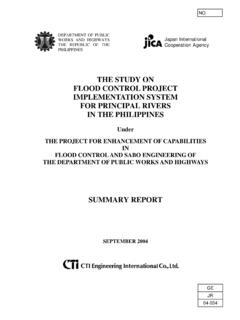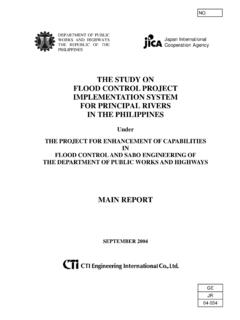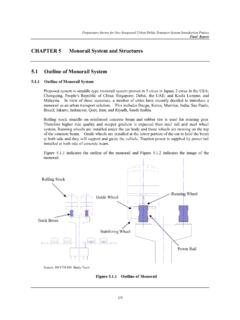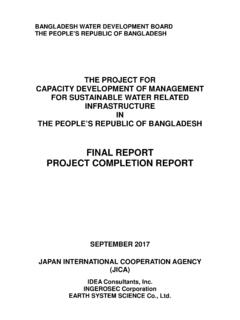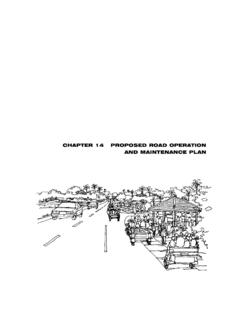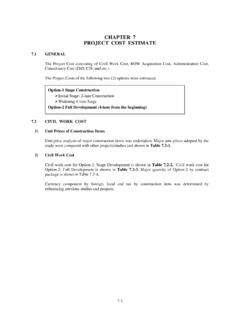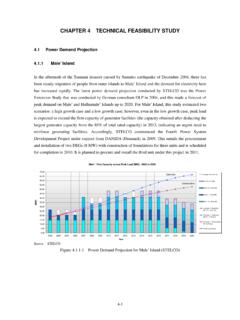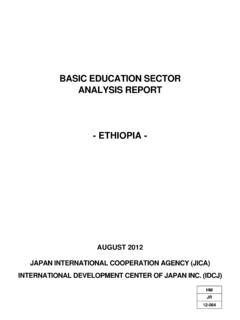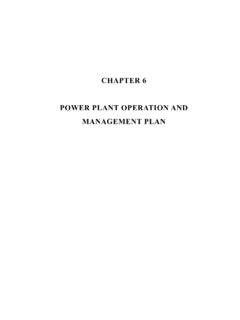Transcription of Guideline and Manual for Hydropower Development Vol. 1 ...
1 Guideline and Manual for Hydropower Development Vol. 1. Conventional Hydropower and pumped storage Hydropower March 2011. Japan International Cooperation Agency Electric Power Development Co., Ltd. JP Design Co., Ltd. IDD. JR. 11-019. TABLE OF CONTENTS. Part 1 Significance of Hydroelectric Power Development Chapter 1 Significance of Hydroelectric Power Development .. 1-1. Chapter 2 Objectives and Scope of Guideline and Manual .. 2-1. Chapter 3 Outline of Hydropower 3-1. Chapter 4 Development Aid Programs .. 4-1. Part 2 Reconnaissance Study Chapter 5 Planning by Reconnaissance Study 5-1. Chapter 6 Preliminary Estimate of Construction Cost and Project 6-1. Chapter 7 Application of Reconnaissance Study 7-1. Part 3 Feasibility Study on Conventional Hydropower Projects Chapter 8 Objectives and Flow of Feasibility Study.
2 8-1. Chapter 9 Power Demand Forecast, Geological and Hydrological 9-1. Chapter 10 Planning of Conventional Hydropower Projects .. 10-1. Chapter 11 Design of Civil Structures .. 11-1. Chapter 12 Design of Electro-mechanical 12-1. Chapter 13 Design of Transmission and Transformation Facilities .. 13-1. Chapter 14 Construction Planning and Construction Cost Estimate .. 14-1. Chapter 15 Environmental and Social Considerations .. 15-1. Chapter 16 Economic and Financial 16-1. Part 4 Feasibility Study of pumped storage Project Chapter 17 Roles of pumped storage Projects in Electric Power System .. 17-1. Chapter 18 Planning of pumped storage Projects .. 18-1. Chapter 19 Design of pumped storage Projects .. 19-1. Part 5 Operation and Maintenance Chapter 20 Operation and Maintenance .. 20-1. Part 1.
3 Significance of Hydroelectric Power Development TABLE OF CONTENTS. Chapter 1 Significance of Hydroelectric Power Development .. 1-1. Chapter 2 Objectives and Scope of Guideline and Manual .. 2-1. Objectives .. 2-1. Scope of Manual .. 2-1. Composition of Manual .. 2-2. Chapter 3 Outline of Hydropower Generation .. 3-1. Energy of Hydropower .. 3-1. Hydropower 3-1. Electric Power Output .. 3-1. Energy Generation .. 3-1. Types of Hydropower Plant .. 3-2. Classification from Viewpoint of Power Supply Capability .. 3-2. Classification by Method of Head Acquisition .. 3-4. Power Demand and Supply .. 3-5. Current Situation on Hydropower Development , and Climate Change and Hydropower .. 3-6. Current Situation on Hydropower Development .. 3-6. Climate Change and Hydropower .. 3-8. Chapter 4 Development Aid 4-1.
4 Development Aid Programs of Japan .. 4-1. Types of Economic Participation Programs .. 4-1. Official Development Assistance (ODA).. 4-1. Technical Cooperation .. 4-2. Training 4-2. Dispatch of Experts .. 4-3. Technical Cooperation Project .. 4-4. Technical Cooperation for Development Planning .. 4-5. ODA Loans (Yen Loan) .. 4-5. General .. 4-5. Type of ODA Loans .. 4-5. Project Cycle .. 4-6. Flow of Yen Loan .. 4-6. Grant Aid Cooperation .. 4-9. Development Scheme by IPP .. 4-9. IPP Project Scheme .. 4-9. i Development Aid Programs by Japanese Government .. 4-12. Development Scheme by PPP .. 4-14. LIST OF FIGURES. Figure 3-1 Run-of-River Type .. 3-2. Figure 3-2 Pondage Type and Reservoir 3-3. Figure 3-3 Types of pumped storage .. 3-4. Figure 3-4 Dam and Waterway Type .. 3-4. Figure 3-5 (a) Example of Daily Load Curve (System Composed Mainly of Thermal Power).
5 3-5. Figure 3-5 (b) Example of Daily Load Curve (System Composed Mainly of Hydropower ) .. 3-6. Figure 3-6 Variation of Rainfall Amount and Influence to GDP Growth and Agricultural GDP Growth .. 3-8. Figure 3-7 Economically Feasible 3-8. Figure 3-8 Changes in Annual Rainfall Due to Global Warming .. 3-9. Figure 4-1 ODA Mechanism of Japan .. 4-2. Figure 4-2 Types of Training Program .. 4-2. Figure 4-3 Trainee Acceptance System .. 4-3. Figure 4-4 Expert Dispatch 4-4. Figure 4-5 Project 4-6. Figure 4-6 Flow of Yen Loan .. 4-8. Figure 4-7 IPP Scheme .. 4-10. Figure 4-8 Oversea Investment Loan by JBIC .. 4-13. Figure 4-9 Structure of Export Loan .. 4-14. Figure 4-10 Partnership among Four Participants to PPP .. 4-15. ii Chapter 1. Significance of Hydroelectric Power Development Guideline and Manual for Hydropower Development Vol.
6 1 Conventional Hydropower and pumped storage Hydropower Chapter 1 Significance of Hydroelectric Power Development (1) Use of undeveloped energy It is now known from available reports that developable potential hydro resources world-wide are equivalent to approximately 14 trillion kWh per year. Most of these hydro resources are located in the developing countries where sharp increases in energy demands are on-going. Development of these undeveloped hydro resources would contribute greatly in easing the global energy demand and supply balance. (2) Global environment issues With the increasing use of energy each year, the combustion of fossil fuel has resulted in an increasing volume of carbon dioxide (CO 2 ), and global warming become an urgent concern with global environmental problems. It has also resulted in acid rain problems caused by gaseous pollutants (Sox & NOx) emissions into the atmosphere.
7 In developing countries, wood and charcoal fuels are the major energy resources, resulting in ever-advancing deforestation and desertification. Under these circumstances, demands for the Development of non-fossil energy sources are growing stronger. Hydropower , especially, is a renewable energy which offers excellent merits against the negative factors of carbon dioxide and other flue gases which contaminate our environment. (3) Economic Development of developing countries With advancing industrialization and strong moves toward better standards of living, the energy demands of the developing countries are rising significantly. The Development of electricity related infrastructures is, therefore, a matter of vital importance to assure sustained growth of the economy. Since hydro power resource is an indigenous and renewable energy, its Development enhances energy self-sufficiency.
8 It also contributes toward improving the balance of payment of international trade and self-sustaining economic growth. With this, through more than 100 years of practical application, Hydropower generation technology is already well established. Transfer of the appropriate technologies to engineers of the developing countries enables production of safe, reliable electric energy. The major construction works for Hydropower plants can be done with domestic currency, thereby providing significant beneficial effects on domestic employment and contributing even further to a nation's economic prosperity. (4) Local energy source Electricity consumption is mainly concentrated in cities and suburban areas and the imbalance with the outlying areas is quite remarkable. A relatively small Hydropower Development plays a significant role in not only providing local electrification, but also in enhancing local prosperity.
9 It responds to basic human needs as the alternative energy replacing wood and charcoal fuel for 1-1. Guideline and Manual for Hydropower Development Vol. 1 Conventional Hydropower and pumped storage Hydropower heating and lighting and as the alternative energy which replaces human and animal labor for irrigation, drainage, drinking water supply, and as motive power for small processing plants. It also contributes to vitalizing local community activities, for instance, the electrification of public facilities such as hospitals and schools improves the local economy, living standards and cultural standards. The small scale Hydropower supplying energy for rural area is described in (5) Stabilization of electricity rate Hydropower generation incurs no fuel costs but the large initial investment is reflected in the large proportion of capital cost in the power production cost.
10 Though the production cost at the beginning of service life is somewhat higher than that for a thermal power plant, no fuel costs means lower unit production cost increase against inflation once the plant is completed, enabling stable, and low priced power supply for a very long period. (6) Efficiency improvement in the entire power system Generally, power demands fluctuate significantly depending on the time of the day. One significant feature of a Hydropower plant controlled with a reservoir or pondage, and a pumped storage Hydropower plant is that it is able to respond instantly to such fluctuations. Contrarily, while thermal power plants provide high efficiency through constant operation, they do not however, have a quick load following characteristic to demand fluctuations. Therefore, the combination of Hydropower and thermal power provides higher efficiency in the entire power system.
